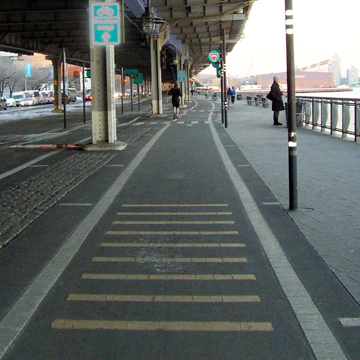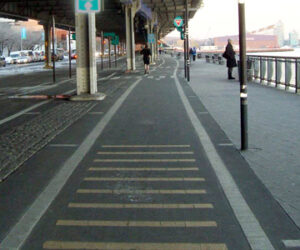Earlier this month, three Community Board 6 committees unanimously approved changes to last year’s Prospect Park West traffic reconfiguration that will help make the already successful project even safer for pedestrians, motorists, and cyclists.
 The alterations were suggested by the city’s Department of Transportation in response to concerns raised by the community once the traffic-calming measures and bike lane were installed. Department representatives discussed those changes in January, following their presentation on the project’s many positive results on safety and cycling along the busy roadway.
The alterations were suggested by the city’s Department of Transportation in response to concerns raised by the community once the traffic-calming measures and bike lane were installed. Department representatives discussed those changes in January, following their presentation on the project’s many positive results on safety and cycling along the busy roadway.
The changes approved by the CB6 committees — Transportation, Environmental Protection, and Permits & Licenses — on March 10 include:
- Low, thermoplastic rumble strips before intersections along the bike lane, which will remind cyclists to slow down at intersections for any pedestrians.
- A narrower buffer between the bike lane and parked cars from Union Street and Montgomery Place. The change, which will make the width of the bike lane consistent all along the route, will allow for slightly wider traffic lanes for cars entering Prospect Park West from Grand Army Plaza.
- Raised, landscaped pedestrian islands in crosswalks that will form safer waiting areas for pedestrians and deter illegal parking in those spots. In its resolution, the board included several conditions, most notably a request to DOT to develop a design for these islands that would be in keeping with Prospect Park West’s historic character.
- A reconfiguration of the drop-off zone at Ninth Street.
- A call by CB6 for “phased signalization” of the bike lanes to help improve pedestrian safety. Push-button-activated crossing signals and better-designed bicycle signals were among the ideas.
The full community board will take up these resolutions at its April 13 general meeting.
More than 300 people came to the public meeting at the John Jay High School auditorium. Of those attendees who signed up to speak before the committees, 86 registered they were in favor of Prospect Park West traffic calming, and 11 were against. (Not everyone could speak due to time constraints.)
The Park Slope Civic Council was one of several community groups providing testimony into the meeting’s record.
President Michael Cairl described how the project was proposed at the Civic Council’s 2006 community forum on transportation, and then followed by several votes from Community Board 6.
“In April 2010,” Cairl said in the testimony, “the Board of the Park Slope Civic Council voted in favor of the proposed reconfiguration of Prospect Park West that included a two-way bike lane installation. The Civic Council’s endorsement arose from the excess capacity on Prospect Park West leading to speeding and creating a dangerous condition for the many users going to and from Prospect Park. The Civic Council also noted that a two-way bike lane would facilitate commuting and transportation options for bikers in Park Slope and adjoining neighborhoods. …
“The Park Slope Civic Council is pleased that Prospect Park West as reconfigured is safer for all users. Pedestrians crossing Prospect Park West now have a shorter crossing of travel lanes and a refuge before crossing the bike path. Yes, pedestrians must look both ways, but that is sensible practice anywhere. Whereas bicyclists used to encroach on the sidewalk on the Park side in particular, this rarely happens now, making the sidewalk safer for pedestrians. Bicyclists approaching the park from Ninth Street are now discouraged from riding directly into the park at that point. Bicyclists and motorists along Prospect Park West are separated from each other, making both groups safer. The reduction in speeding along Prospect Park West that the Department of Transportation has recorded creates a safer situation for all users — pedestrians, bicyclists, and motorists — all of whom make up the transportation mix in Brooklyn and the city.
“What this reconfiguration is about is creating a livable street. In that respect, the results speak eloquently for themselves. It is reasonable that the city provide a safe environment for all users of its streets. Prospect Park West today does that.
“There are members of our community who for many reasons do not like what has been built, and that is their right. There are legitimate and principled differences of opinion on how to achieve safe streets and about the reconfiguration of Prospect Park West. Were there other ways to achieve traffic calming here? Certainly. Is the current condition perfect? No. Community Board 6 and others have proposed improvements to lines of sight, buffering, signage, and signaling, all of which will make a good installation much better. The Civic Council urges the speedy implementation of these improvements.
“Nearly four years after Community Board 6’s endorsement of elements of the Prospect Park West reconfiguration, and nearly one year after it was accomplished, we are still here arguing. Our city councilmembers, Brad Lander and Steve Levin, together commissioned a community survey concerning the reconfiguration. Over 3,000 people responded and three-quarters expressed their approval. Now some are taking issue with the Department of Transportation’s public and in-house process that led to the reconfiguration. With all due respect, taking issue with the process here is a red herring; had the identical process led to the opposite outcome, we would not be here this evening.
“We are fortunate to live in a place where we have many options for making our local journeys. We are just as fortunate to be able to accommodate all users, including bicycles, now an important part of the local transportation mix. But this mix depends absolutely on all users being mindful and respectful of each other, and accepting that we all have a place here. Matt Seaton in the British newspaper The Guardian put it perfectly:
“‘New York City justly sees itself as the world’s greatest city: here, in some sense, people live the way everyone would live if they had the chance. How New York — the city that still has a uniquely low level of car ownership and use — manages its transport planning in the 21st century matters for the whole world: it is the template. If cycling is pushed back into the margins of that future, rather than promoted, along with efficient mass public transit and safe, pleasant pedestrianism, as a key part of that future, the consequences will be grave and grim.’
“Our streets belong to everybody. Prospect Park West is no exception.”
from the March 2011 Civic News

